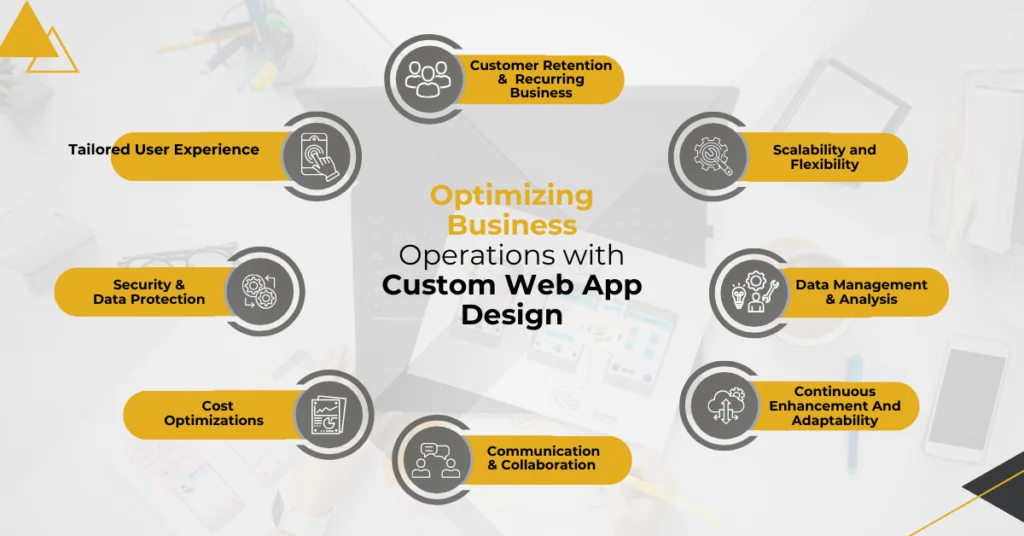Introduction
Custom web app development is the new ‘IT’ thing in the software world (pun intended). Previously, custom web application development was reserved for big organizations with the bandwidth and budget to innovate. Custom web app designs were a luxury, benefiting only those enterprises with substantial resources at their disposal. Smaller businesses and startups often found themselves constrained by off-the-shelf solutions that could not fully align with their unique processes and goals. The Custom Software Development Services Market was valued at an impressive USD 8.17 Bn. in 2022. Forecasts suggest that the total revenue from Custom Software Development Services is expected to grow by 8.77% from 2023 to 2029, potentially reaching a substantial value of nearly USD 14.72 Bn. This growth trend underscores how technology has evolved, making development tools more accessible to a broader audience and creating a notable shift in the custom web application development landscape.
In today’s business environment, custom web application development has surpassed its former status as a simple technological pursuit; it has evolved into an imperative for organizations of all sizes. With the current Compound Annual Growth Rate (CAGR), this burgeoning market is projected to continue its upward trajectory, potentially reaching significant milestones by 2029. These organizations now recognize the necessity of creating robust and scalable solutions that precisely align with their unique operational demands.
The prevalence and significance of web applications in modern-day businesses are no surprise. Whether optimizing workflows, managing financial operations, or enhancing customer interactions, companies increasingly seek tailored remedies for each facet of their operations through custom web app development. The era of relying on off-the-shelf (OTT) software as a universal solution to diverse business challenges has long passed. The current digital-first, mobile-first landscape demands adaptability and customization that can only be effectively met through bespoke web applications.
Want to know the difference between OTT and Custom software? Read: Off-The-Shelf Vs. Custom Software Development.
Looking for a custom web app development service provider?
At AlphaBOLD, we offer end-to-end support for your custom web app development needs, from initial strategy and implementation to quality assurance and post-production.
Request a ConsultationKey Components Of Web Application:
Custom web application development encompasses many components, each contributing to the seamless functionality and engaging user experience. These include the following:
Frontend Development:
- User Interface (UI): The visual design and layout of the application users interact with.
- User Experience (UX): Optimizes users’ usability and overall experience while interacting with the UI.
- HTML (Hypertext Markup Language): The standard markup language for creating web pages and structuring content.
- CSS (Cascading Style Sheets): Used to control the presentation and styling of the HTML elements.
- JavaScript: A programming language that adds interactivity and dynamic behavior to web pages.
Backend Development:
- Server: The central processing unit handles client requests, processes data, and communicates with databases.
- Application logic: The code manages the application’s functionality, processes user input, and generates responses.
- Databases: Store and manage the application’s data, allowing users to retrieve, update, and manipulate information.
- Server-side scripting: Backend scripts that execute on the server to perform tasks and generate dynamic content.
- APIs (Application Programming Interfaces): Interfaces that enable communication between different software components, allowing them to interact and exchange data.
Database Management:
- Database Management System (DBMS): Software that manages, organizes, and stores database data.
- Data Models: Define the structure and relationships of the data stored in the database.
- Query Language: Allows developers to interact with the database to retrieve, update, and manipulate data.
User Authentication And Authorization:
- Authentication: Verifying the identity of users to grant access to the application.
- Authorization: Determining the permissions and actions a user is allowed to perform within the application.
Security Measures:
- Data Encryption: Protecting sensitive data by converting it into a code to prevent unauthorized access.
- Secure Socket Layer (SSL)/Transport Layer Security (TLS): Ensures secure data transmission between clients and servers.
- Input Validation: Checking and sanitizing user input to prevent security vulnerabilities like SQL injection and cross-site scripting.
Web Servers And Hosting:
- Web Server: Software that serves web content to users’ browsers upon request.
- Hosting: Storing and making the application accessible on a web server, either on-premises or through a hosting provider.
Frontend And Backend Integration:
- Client-server communication: Techniques like AJAX (Asynchronous JavaScript and XML) or Fetch API to enable data exchange between frontend and backend without requiring full page reloads.
Version Control:
- Git: A distributed version control system that tracks changes to source code, enabling collaboration among developers and code management.
Testing And Debugging:
- Unit testing: Testing individual components or functions of the application to ensure they work as expected.
- Integration testing: Testing interactions between different components to ensure they function correctly.
Deployment And Scalability:
- Deployment: Making the application accessible to users on a live server.
- Scalability: Designing the application to handle increased load and user traffic without compromising performance.
Want to learn more? Read: Custom Web Application Development: A Complete Guide For C-Suite.
Ready to Innovate?
Dive deep into the world of custom web applications with AlphaBOLD. Let's discuss your digital aspirations!
Request a ConsultationOptimizing Business Operations with Custom Web App Design
The integration of custom web applications into business processes holds the potential to effect transformative changes. These applications eliminate reliance on disparate spreadsheets and manual workflows by centralizing data and automating tasks. The outcome is refined operational efficiency, reduction in human errors, and streamlined procedures. Access to real-time, up-to-date information empowers informed decision-making, optimizes resource allocation, and generates precise reports effortlessly.

Tailored User Experience:
User experience (UX) is a pivotal factor in determining the success of a web application. A well-conceived user interface enhances engagement, navigation, and overall user satisfaction. Custom web applications allow businesses to customize the user experience for their intended audience, ensuring seamless cross-browser and cross-device compatibility. With rapid loading times and intuitive navigation, a custom web application engenders an immersive experience, stimulating user interaction and exploration of the website.
Scalability And Flexibility:
The inherent adaptability of custom web applications renders them invaluable assets for businesses aspiring to expand and evolve. Tailoring these applications to meet client needs engenders a personalized experience conducive to client satisfaction and loyalty. Scalability is paramount for accommodating high levels of concurrent users without encountering downtime. As businesses pursue growth, the scalability of custom web applications guarantees their ability to manage increased demand and adapt to evolving market conditions.
Enhanced Data Management And Analysis:
Data-centric decision-making constitutes a cornerstone of contemporary business strategies. Custom web applications can incorporate robust analytics tools from inception, empowering businesses to monitor key performance indicators (KPIs) and track business performance over time. Dashboards provide real-time insights into dynamically shifting metrics, facilitating data-driven planning and decision-making. Data harnessing enables businesses to identify trends, evaluate past performance, and optimize future engagements.
Elevated Security And Data Protection:
In an era of heightened cybersecurity concerns, custom web applications present advanced security measures to safeguard sensitive data and ensure secure user interactions. These applications are fortified with sophisticated security features capable of detecting and addressing potential breaches. This engenders user confidence, enabling secure transactional and informational exchanges. The robust security protocols of custom web applications establish them as reliable platforms for secure online interactions.
Competitive Edge:
Attaining a competitive edge is a pivotal objective for businesses seeking differentiation and success. Custom web applications offer diverse avenues through which businesses can realize a competitive advantage. By delivering superior products, exceptional customer experiences, innovative technologies, and efficient processes, businesses can attract a larger customer base, augment market share, and foster revenue growth.
Cost Optimization:
Custom web application development represents a cost-effective alternative to creating distinct mobile applications for various operating systems. Developing a single software version that supports multiple platforms saves businesses time and resources. While the initial investment might surpass template utilization, the long-term gains from customization, brand alignment, and enhanced user experience outweigh the initial costs.
Rationalized Communication And Collaboration:
The centralized data and streamlined processes facilitated by custom web applications catalyze efficient communication and collaboration within organizations. Businesses can eliminate the need for disparate spreadsheets and disjointed communication channels. All data resides within a single location, augmenting precision and enabling real-time reporting. This streamlined approach heightens productivity and ensures a unified team focus on shared objectives.
Continuous Enhancement And Adaptability:
Adaptability and continuous improvement are essential for sustaining success within a rapidly evolving digital landscape. Custom web applications can be systematically updated and refined to remain pertinent, secure, and optimized for performance. An agile development process empowers businesses to respond promptly to evolving requirements, ensuring the application’s resilience in the face of technological advancements and user demands.
Augmented Customer Retention And Recurring Business:
Custom web applications empower businesses to craft tailored experiences for their target demographic. Businesses can design compelling and persuasive websites resonating with customers by comprehending market trends and user preferences. This personalized approach augments customer retention; fosters repeat business and stimulates revenue growth by catering to each user’s unique needs and inclinations.
Discover the Power of Custom Web Apps
Connect with AlphaBOLD today and unlock transformative solutions tailored to your business needs!
Request a ConsultationConclusion:
Custom web application development has emerged as a strategic imperative for businesses aiming to thrive in an increasingly digital-centric landscape. The advantages, from streamlined processes and personalized user experiences to scalability, data management, security, competitive edge, cost optimization, and continuous enhancement, provide compelling rationales for investing in custom web applications. Through a comprehensive understanding of these benefits and effective collaboration with experienced development teams, businesses can harness the full potential of custom web applications to elevate their operations, engage customers, and achieve sustained growth.
Explore Recent Blog Posts








